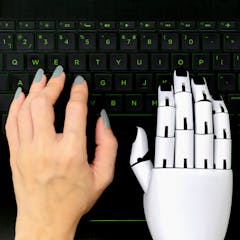
Articles on Robots
Displaying 61 - 80 of 349 articles

Robots are taking jobs, but they’re also saving lives … should we fear them and their capabilities?

This robot can learn how to traverse unforeseen terrain by changing the length of its legs.

As the use of robots and autonomous machines increases across industries, governments need to have a strategy in place. The labour force will transition out of automated tasks into new jobs.

Robots and humans can be friends – but not in a way that would win Aristotle’s approval.

Our children should no longer be taught formulaic writing. Writing education should encompass skills that go beyond the capacities of artificial intelligence.

The robots are ‘born’ via 3D printer, and recycle themselves upon their ‘death’.

The revolution in AI harbours dangers for humanity – here’s why.

In the future, tiny robots will inspect pipes for blockages and leaks.

The 1921 play R.U.R. introduced the world to the word ‘robots’. Its plot is remarkably similar to robot stories told today.

Philosophers say now is the time to mull over what qualities should grant an artificially intelligent machine moral standing.

Leading tech companies are increasingly using AI to influence our behaviour. But how persuasive do we find virtual assistants?

AI, robots and other technologies could transform farming – for worse as well as for better.

Using robots to provide companionship is a slippery slope in removing the aged and infirm still further from human interaction.

A new silicone ‘skin’ contains electronics that mimic the human body’s lightning-fast response to pain, potentially paving the way for smart prosthetics that can detect painful sensations.

Increased capital investment and productivity need not result in job losses. Government can use industrial policy to link investment incentives to job preservation and even job creation.

Wild dolphins are fast, smart and hard to study, but it is important to understand how human actions affect their health. So we are building a drone to sample hormones from the blowholes of dolphins.

That gentle voice coming from your smart speaker is more complex than she seems.

Smart city solutions have proved handy for curbing the contagion, but recent experience has also shown how much they rely on public trust. And that in turn depends on transparency and robust safeguards

Amazon’s planned upcoming ‘Just Walk Out’ technology will let customers take items off a store’s shelf, bag them, and walk straight out.

Algorithms are only as good as the people who make them.
